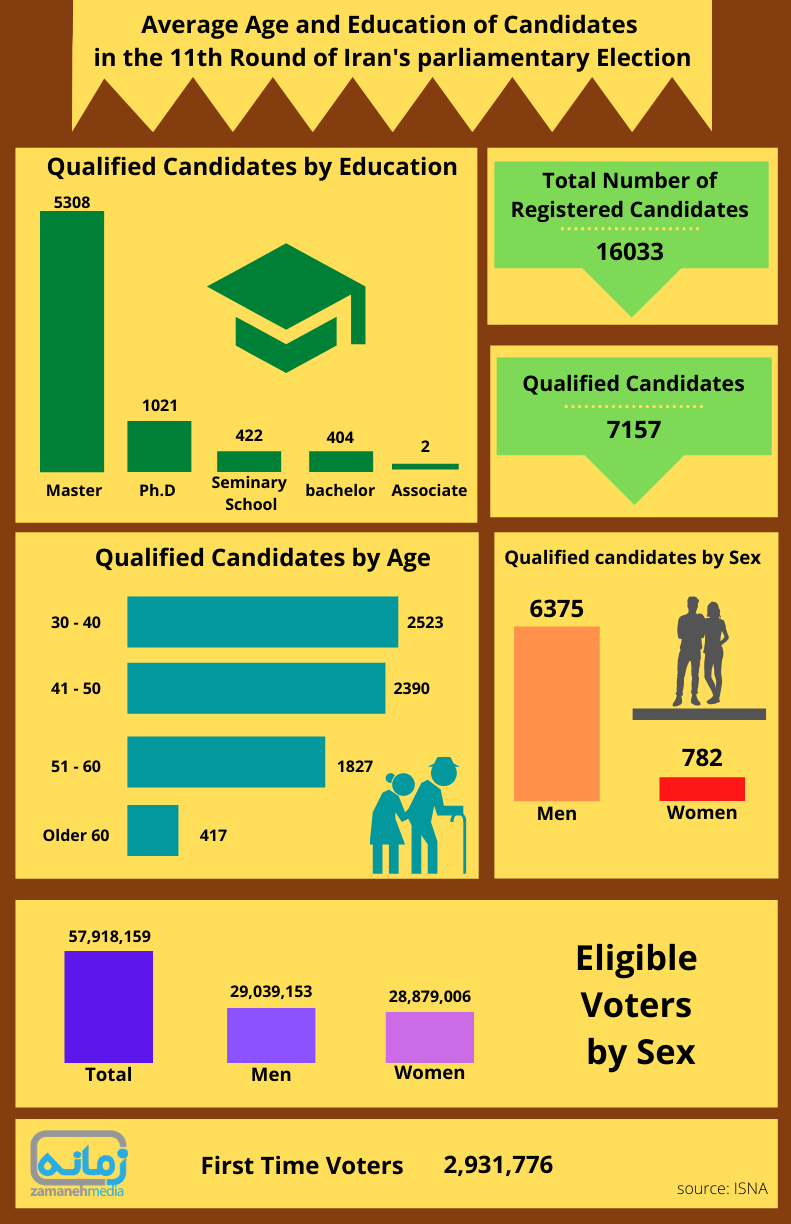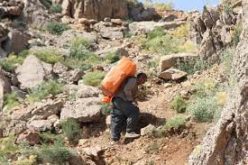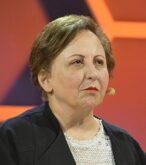Radiozmaneh – The 11th round of parliamentary elections in Iran will be held on February 21, 2020, with 290 seats to be filled for a four-year term through a nationwide vote.
The Iranian Parliament is called “the Islamic Consultative Assembly” or “Majlis.”
According to article six of the Islamic Republic’s constitution, the country’s affairs must be administered by reliance on the public vote through elections. These will include the election of the parliament’s members.

Iran’s population is almost 83 million people, and there are about 58 million eligible voters (citizens over 18 years old).
Iran’s Constitution mandates five seats out of 290 seats in the parliament to be reserved for religious minorities who are the followers of Zoroastrian, Jewish, and Christian faiths.
Is the Election Free and Democratic?
“Guardian Council of the Constitution” or “Shūrā-ye Negahbān” vets the candidates and oversees elections.
Guardian Council consists of 12 members. Half of its members are specialists in Islamic law and appointed by the supreme leader of Iran. The other half are jurists who are specialists in law. These lawyers are nominated by the Supreme Judicial Council and appointed by the Parliament.
The primary duty of the Council of Guardians is reviewing all legislation passed by the Parliament to determine its constitutionality and its accordance with Islamic laws. Guardian Council also qualifies the candidates of all parliamentary and the presidential election. The rate of disqualification by the Guardian Council is usually high.
In the previous parliamentary election in Iran (the 10th round), the guardian council disqualified about 60 percent of the candidates.
The record of disqualification of the candidates goes to the seventh parliamentary election in Iran in February 2004, when the Guardian Council disqualified 3,605 candidates representing more than forty-four percent of registered candidates nationwide. Two thousand of the banned candidates were reformists, and in the 2004 parliamentary election, conservatives won a landslide.
In this round so far, thousands of the candidates have been disqualified, and among them are even the current members of the parliament.
In total, 16,032 people registered as candidates and the Guardian Council disqualified 7,148 of them. The rate of disqualification in this round is about 44 percent.
ISNA agency reported that 70 members of the 10th Iranian Parliament has been disqualified and cannot run for the 11th Parliament.
The vetting process remains shrouded in secrecy, but the candidate has been told about the reasons for disqualifications unofficially.
Mahmoud Sadeghi is currently a member of the Iranian parliament, representing Tehran, Rey, Shemiranat, and Eslamshahr electoral district. Sadeghi, a reformist, claims that a jurist member of the Guardian council told him that he had been disqualified because of his tweets and his speeches.
Gholamreza Ansari, a former member of Tehran City Council, has also been disqualified because of not attending the public prayers regularly. Gholamreza Ansari is also reformist.
Ali Motahari, however, is a conservative member of the parliament. He represented Tehran, Rey, Shemiranat, and Eslamshahr electoral district in the Parliament of Iran since 2008 and was Second Deputy of the Parliament of Iran from 2016 until 2019. He claimed that he had been disqualified because of his speeches.
It seems that some of the current candidates have been disqualified because of their speeches in parliament. According to the Iranian Constitution, the parliament representatives are entirely free to express their opinions during the performance of their duties as the Parliament Representatives. They may not be prosecuted or detained on account of the views that they may express in the Parliament or consequence of the votes they cast in the exercise of their duties as representatives. Neither will they be deprived of their social rights for the said reasons.
Right vs Left
The Islamic Republic of Iran (IRI) consolidated its power by violently suppressing both right-wing liberals and left-wing socialists and communists. However, up to Mohammad Khatami’s surprise win in the 1997 presidential elections, the main political tendencies in post-revolutionary Iran had been called “the Left” and “the Right”.

The differences between these two political currents inside the Islamic Republic elite came to the forefront after the impeachment and subsequent escape of Abolhassan Banisadr, the first elected president.
The right-wing of the IRI consisted of traditional merchants (Bazaaris), traditional clergy, and opponents of land reforms and critics of State interventionism in the economy.
The left-wing of the Islamic Republic had the support of Ruhollah Khomeini in the first years of the revolution. They called for the redistribution of wealth through subsidies, direct distribution of essential goods, and heavy regulations on the free markets.
Both political wings supported the Islamization, the Guardianship of the Islamic Jurist (Velayat-e-Faghih), and anti-imperialist discourses.
The third parliament was controlled by the left. However, after Khomeini’s death and Khamenei’s ascent to supreme leadership as a right-winger, the left became weaker and weaker. Fourth and Fifth parliaments were controlled by the right.
After Khatami’s election in 1997, the duality between left and right was reformulated in another duality, reformists versus conservatives (or principalists). The past differences between left and right in terms of economic policies are no longer a dividing issue here, as many reformists and conservatives are now advocates of the free market, globalized trade, and privatization.
How Much Power Does the Majlis Have?
The ultimate power is in the hand of the Supreme Leader Ali Khamenei. The elected officials, including the president, members of the parliament, and the city councils, have limited power in the political structure.
Since the supreme leader as the guardian of Muslim citizens is the ultimate decision-maker, the decisions made by the elected bodies always could be overruled officially or behind the scenes by the Supreme Leader.
Who is Competing?
Reformists (Eslâh-Talabân)
Reformists in Iran support gradual reforms and change within the framework of the current constitution, without any regime change, revolution or abolition. They believe that the Islamic Republic of Iran has lost its way after the death of Ayatollah Khomeini.

Reformist faction created when Mohammad Khatami won the presidential election in 1997. The reformists were seeking more freedom and democracy through gradual reforms.
Khatami’s popularity, especially among the youth, and winning 70% of the votes in his first term gave his supporters a boost. Golden years of reform lasted from 1997 to 2005—the length of Khatami’s two terms in office. A series of events and failure to fulfill promises, especially in terms of political and social freedom, weakened the position of the reformists domestically and internationally.
During a period in the late 1990s and beginning of the 2000s, the reformists briefly gained control of both the presidency and the parliament. However, the judiciary blocked their efforts to reform, shut down reformist newspapers, and imprisoned their leading figures.
After two decades, the term “reform” and “reformists” in Iranian politics is now tainted. Several other Iranian opposition groups, as well as former reformists, accused the reformists in the government of being immoral opportunists. For them, those reformists who stayed in power have been dishonest about their will to change. Opposition in exile, especially in recent years, considers them a part of the system.
Some analysts suggest that the last nail has been hammered on the coffin of the reform when reformists failed to condemn the violence against protesters in recent years.
In December 2017 and November 2019, more than a hundred Iranian cities witnessed popular protests, but the security forces conducted a violent suppression. Reformists did not support the nationwide protests in Iran and distanced themselves from the protesters.
Reformists Views
The leading reformists’ parties in Iran are the Executives of Construction of Iran Party (Kargozaran), Union of Islamic Iran People Party (Ettehad Mellat), the Association of Combatant Clerics (Majma Rohanion Mobarez) and House of workers (Khaneh Karagar).
Reformists consist of about 30 different groups that necessarily do not agree on every issue. Their views on politics, economy, and social issues are different.
For example, the House of Workers (Khane Kargar) supports the state-controlled economy and intervention in the markets. On the other side, the Executives of Construction of Iran Party (Kargozaran) supports privatization.
When it comes to foreign policy, the reformists are unified in supporting the Joint Comprehensive Plan of Action (JCPOA), better known as the Iranian nuclear deal.
In terms of social issues, the reformists want more freedom for media and parties, and they continuously ask for a stronger civil society. In general, they are opposing radicalism in all areas.
There are two leading circles within the Iranian reformists.
Circle of Kian supported Khatami and the circle of Niavaran, which supports Rouhani.
Kian circle are left-Islamists, and Niavaran circle are mostly technocrats.
Reformists in Elections
Reformists received the best result in the 2000 parliamentary election when received a majority (69.25%), or 26.8 million, of the 38.7 million voters who cast ballots on February 18, 2000, first round. Ultimately reformists won 195 of the 290 Majlis seats in the 6th round of Iranian Parliament.
In the 2020 election, 90% of the reformist candidates have been disqualified so far. There is a confusion in reformists camp now. Reformists High Council of Policies has announced that they will not enter into any coalition. However, some other reformist factions have separately supported different lists.
Majid Ansari, Alireza Mahjoob, and Mostafa Kavakebian are the most well-known reformists who are competing for the 11th Parliament.
Principalists (Osul-Garâyân)
Principalists are considered right-wing conservatives in Iranian politics. They are mostly hardliners, loyal to the supreme leader, and religiously conservative. They are close to the Islamic Revolutionary Guard Corps (IRGC), conservative clerics and traditional Iranian merchants (Bâzaaris).

The principalists advocate for protecting the ideological ‘principles’ of the 1979 Iranian Revolution.
The structure of the Iranian political system is in the hand of hardliners. Revolutionary Guards, the Guardian Council, the Judiciary, and the assembly of experts are in control of conservatives. State-Run TV is also controlled by them.
Hassan Rouhani, the Iranian president, has criticized the accumulation of power in Iran and said: “money, gun, and media are all in the hand of one institution in Iran.”
Ghalibaf Circle
Mohammad Bagher Ghalibaf is the former mayor of Tehran, the former commander of the Revolutionary Guards’ Air Force and an Iran-Iraq war veteran. Ghalibaf ran for the presidential election in 2005, 2013, and 2017 and was defeated in all three times.
He was the longest-serving mayor of Tehran and still has an open case of a multi million dollar corruption in a case that is related to his leadership of the municipality.
Ghalibaf is accused that during his mayorship, he donated 600 billion rials and 80,000 square meters of land to his wife’s charity. Many analysts expect that if he wins the election, he will be the next speaker of the parliament.
Ghalibaf is said to be the spiritual leader of the “Progress and Justice Population of Islamic Iran and Iranian Islamic Freedom Party.” Another candidate who is running under the support of this party is Mohsen Pir Hadi,
Ghalibaf circle or Neo-fundamentalists believe in the necessity of “fundamental change” in fundamentalism current, change the culture of ageism, and let the younger generation run the country. They want the principalists to return the Khomeini’s school of thought, which is Islam and people.
Their main slogan is “believing in the people.” In their definition, “believing in the people” means to replace the governmental economy with an economy that has “the people” in the center. They also believe in smaller central government and letting the people run their cities and towns. In their manifesto, the words of “justice”, “wisdom”, “spirituality”, “modernity”, and “youthfulness” are repeated frequently. However, they are not offering any specific plan on economy, culture, and foreign policy.
The party also declares that anti-imperialism as their primary ideological value.
Spring Motion (Jaryân-e-Bahâr)
Mahmood Ahmadinejad’s supporters call their political movement as “the Spring Current” or “the Spring Motion.”
Ahmadinejad, the former president of Iran, used to call his administration “Dowlat-e bahar” (the government of Spring).
He claimed that his government is the beginning of a new season in the Islamic Republic era – a spring season of renewal.
Most of the candidates who are supported by the Spring Current were connected to Ahmadinejad’s administration, including former ministers, governors, and undersecretaries. They are known as right-wing populists, and they call themselves “pragmatic principalists.” The average age of this faction is around 50 years old. They are younger than traditional principalists and older than Ghalibaf circle.
They are not seeking a majority in this parliament and expected to be a fraction in the Parliament and have a minimum voice.
Ahmadinejad is not supporting any specific list in this election.
Mohammad Tarighat Monfared, Reza Taghi Pour, and Seyed Mohammad Hosseini are the candidates for the Spring Current.
Stability Front
Front of Islamic Revolution Stability (Jebheye Paydari) split from the Spring Current.
Ayatollah Taqi Misbah, known as Misbah Yazdi, a hardliner cleric, is the spiritual father of this faction.
Members of Stability Front are promoting Islamic education and training; they are criticizing western lifestyle and support the Islamic way of living. They are also against secular societies. Mesbah followers believe everything, including the economy, should be Islamic.
When it comes to foreign policy, opposing JCPOA and Israel is on the top of their agenda.
Morteza Agha Tehrani, Alireza Zakani, Mojtaba Zolnoor, Seyed Mahmoud Nabavian, Bijan Nobaveh, and Vahid Yaminpour are in the current stability list.
Traditional Principalists (Jamna, Motalefeh, and Bazar)
Traditional principalists have been active since before the 1979 Revolution in Iran.
The Islamic Coalition Party (Hezb-e Moʾtalefeh-ye Eslāmi), founded in 1963, is one of the traditional conservative political parties in Iran that favors economic liberalism.
The traditional principalists are usually very close to Bazaar – the traditional market economy. “The Popular Front of Islamic Revolution Forces” (JAMNA), founded in late 2016 by ten figures from different spectrums of the conservatives, is also considered a traditional principalist body.
The Islamic Coalition Party (Moʾtalefeh) believes that its mandate is establishing the Islamic revolution values, an Islamic justice system, and eventually, the global justice governing system by free elections. Their main agenda is building an Islamic society. They don’t have any specific written manifesto, but their leaders have always and openly spoken against negotiations with the United States.
They claim to support Bazaar (traditional economy) and, at the same time, the underprivileged classes (Mostazafin in IRI’s terminology).
Mostafa Mir Salim, Gholamreza Mesbahi Moghaddam, Abdolhosein Rooh Alamini, Fatemeh Rahbar, Elias Naderan, and Zohreh Elahian is in the list of traditional fundamentalists.
Moderates
Moderation and Development Party (Hezb-e E’tedāl va Towse’eh) is a centrist political party founded in 1999 with the direct support of Akbar Hashemi Rafsanjani, a former Iranian president, and house-speaker.
They are mostly technocrats who support president Rouhani. As neo-reformists, they believe in diplomatic engagement with the West, economic expansion, and the free market.
Independents
Independent candidates are mostly coming from small cities and towns. They could attract the votes of their constituents based on their history and background and their local networks.
After entering the Parliament, these candidates have the swing vote. The strongest appearance of the independents was in the 10th Majlis, where 65 members of the Parliament introduced themselves as independents.

 Shabtabnews In this dark night, I have lost my way – Arise from a corner, oh you the star of guidance.
Shabtabnews In this dark night, I have lost my way – Arise from a corner, oh you the star of guidance.



